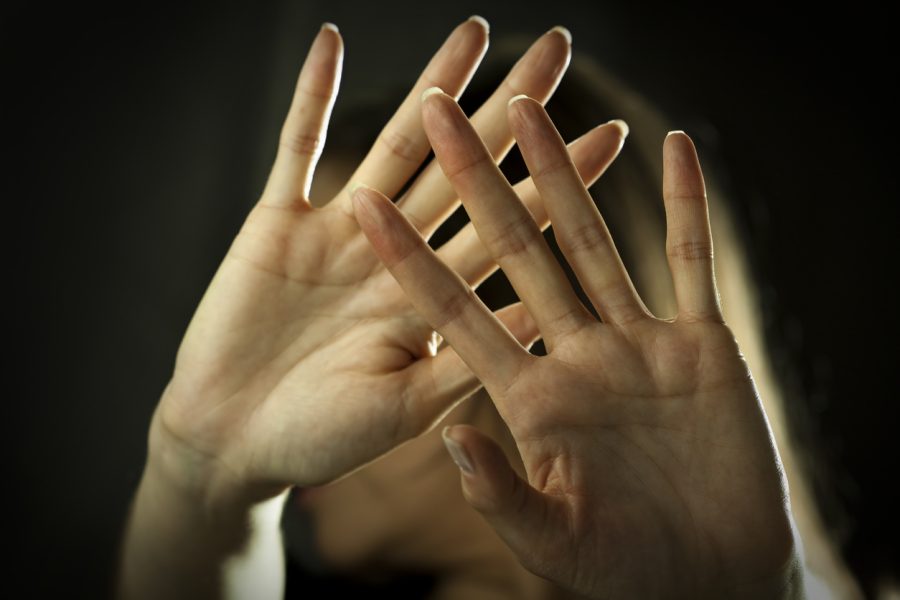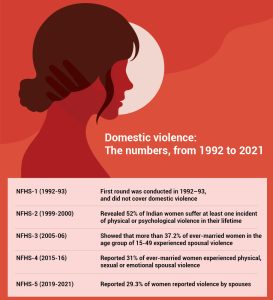
Examined: Why Karnataka tops the list of women suffering spousal violence
Work participation of women has come down, and the state has fewer support systems in place, says activist Vibhuti Patel; all-India domestic violence numbers are alarming, too

Indian women may have broken many glass ceilings but there’s one space where they still don’t feel completely safe: their own home. Data in the National Family Health Survey-5 (2019-21), which was recently released by the Union Health Ministry, show that one third of married women, that is one in every three women in the age group of 18-49 years in India, experience physical, sexual, or emotional spousal violence.
This is a continuing trend, say women activists. NFHS-4 too showed that 33 per cent of Indian women were victims of spousal violence. However, what raised eyebrows is the fact that Karnataka, the IT capital of India, recorded the highest numbers with respect to women suffering from spousal violence. The survey shows that among the states and UTs, 48.4 per cent of women in Karnataka suffer from spousal violence, followed by Bihar with 43 per cent, Telangana at 41 per cent, and Manipur and Tamil Nadu at 40 per cent each.
In NFHS-4 (2015-16), Karnataka had just 20.6 per cent women in the state saying they faced spousal violence. The number seems to have doubled in the current survey. Manipur had topped the list in the previous survey with a high of 55 per cent.
Puducherry too seems to be high on the list at 31 per cent, while women in Lakshadweep seem safer at 2 per cent. The report stated: “Women’s experience of any spousal physical, sexual, or emotional violence varies greatly across states/UTs, from 2 per cent in Lakshadweep to 10 per cent in Himachal Pradesh and Goa and 11 per cent in Mizoram and Chandigarh to 40-41 per cent of women in Manipur, Tamil Nadu, and Telangana and Karnataka at 48 per cent.
Kinds of violence
THe NFHS-5 data also shows that the most common type of spousal violence happens to be physical (28 per cent), followed by emotional (14 per cent), while sexual violence in married women hovers around 6 per cent.There is also economic violence, where women are deliberately deprived of money.

The study correlated fear of husband and spousal violence since women who say that they are afraid of their husband most of the time are most likely to have ever experienced spousal violence (59 per cent), followed by women who are sometimes afraid of their husbands (34 per cent). Of the acts of physical violence, the most common type is slapping, reported by 25 per cent of the married women. The form of sexual violence most commonly reported by women is that their husband used physical force to have sexual intercourse when they did not want to (5 per cent).
There’s another type of violence the NFHS data addresses – emotional violence. Women reporting emotional violence are most likely to report that their husband said or did something to humiliate them in front of others (10 per cent), followed by their husband insulting them or making them feel bad about themselves (9 per cent). Six per cent of women said that their husband threatened to hurt or harm them or someone close to them.
Also read: Sharpest fall in population growth rate has been among Muslims: NFHS-5 data
The NFHS-5 National Report, which is considered to be the best source for reliable data on women’s health and other emerging areas, lists progress from NFHS-4 (2015-16) to NFHS-5 (2019-21) facilitating comparisons.

In an interview with The Federal, Vibhuti Patel, women’s rights activist, (also vice-president of the 40-year old Indian Association for Women’s Studies) and chairperson of the ethical review board of the International Institute of Population Sciences, which conducts the NFHS surveys, discussed the findings on spousal violence. Edited excerpts:
What is your view on the NFHS 5 statistic showing one-third of women in India facing spousal violence?
That’s a continuing trend we see from NFHS 4 as well. It may have come down from the 2nd round back in 1999-2000, which was at 52 per cent, but we have not made much headway in the past six years. It is largely because of the way Indian men continue to treat women as property. And, what with the current wave of the right wing policies that have eroded all support structures such as Samakhya programme, shelter homes for women in difficult circumstances when backlash of violence has escalated across the class and education levels of women. Nearly 80 per cent of adult women are out of the workforce, totally dependent on their husbands and forced to stay in a violent home where wives are treated as private property and as a domestic slave. How can it change significantly?
Women activists have expressed surprise that Karnataka has topped the list. What is your opinion?
I would say that decline in the work participation of women that enhances their vulnerability can be one reason. A microfinance movement was robust in all the four southern states; the state’s efforts to empower women with the Samakhya scheme and the women’s rights movement in urban areas have all weakened. Then where do women go? Why do women persist in a violent situation? It is because they don’t have an alternative. In the 1980s and ‘90s, women’s support groups were much more active. They were providing temporary shelter, counselling, legal services and support to rebuild the shattered lives of the survivors of domestic abuse.
The whole generation of women activists have disappeared and states have not stepped in to provide alternatives. What they have is all on paper. This year’s budget for the social sector is 1 per cent; within this, gender responsive budget is less than 1per cent of the GDP. Capital expenditure has usurped 99 per cent of Union Budget 2022-23’s budgetary allocations.
In my opinion, Karnataka does not have effective support structures. They do not have effective One Stop Crisis Centres, which function well in Mumbai. We have these centres in 13 municipal hospitals to tackle gender based violence. They are found in the casualty ward of the hospital, where under one roof women get the services of police, counsellor, shelter homes, legal services and medical help. For effective implementation of Protection of Women from Domestic Violence Act, 2005, five service providers have a crucial role – protection officers, government hospitals, police, legal system, emergency shelter. Currently, there are no gender sensitisation training programmes for the service providers in Karnataka.
We don’t hear about the budgetary allocations that Karnataka has made to implement the Prevention of Domestic Violence Act, 2005. How many shelter homes does Karnataka have? The state does not have the legacy to provide support for women in distress like they do in Mumbai. During the 1980 and ‘90s, in Karnataka, Vimochana, Shakti etc., were around but support structures have eroded now.
Are there other factors at play in Karnataka as well?
Another major factor is the declining work participation of women in the state. Except probably for sunrise sectors like IT, there has been a tremendous marginalisation of women in the workforce. As per the National Sample Survey, the participation rate of rural women in Karnataka decreased from 38 per cent in 2000 to 28.7 per cent in 2011-12 (usual status definition), while the rate for urban women increased marginally from 14.6 per cent to 15.5 per cent over the same period.
With commercialisation of the agriculture sector replacing subsistence farming by women, the process of defeminisation has set in; women’s involvement in handicraft and cottage industries has come down with the dumping of Chinese products. This lack of work makes them economically vulnerable, creating more powerlessness, and they become more exposed to violence.
The neo-liberal ideology has taken away the fabric of community life and kinship. Migration of every kind has eroded the social fabric which had elders who would intervene to stop violence. Nuclearisation of the family is complete. According to the Agriculture Commission Report, nuclear families are high among agricultural labourers. These nuclear families are unable to face the ups and downs of survival struggles due to the agrarian crisis caused by liberalisation and often the women face the brunt of all the stress.
Which are the states doing well on this front?
There are only six states which are applauded on this front and proactively deal with violence against women. They are Delhi, Maharashtra, Madhya Pradesh, Mizoram, Manipur and Nagaland. There was a bell bajao movement in UP which no longer exists. Andhra Pradesh meanwhile actively implements the DV Act, raises awareness, has protection officers, provides continuous training to service providers etc. In Kerala, Kudumbashree provides support to women suffering violence. In Mizoram, Manipur and Nagaland the State Commissions for Women work in tandem with community-based women’s organisations.
Why do some states register low numbers?
In Himachal Pradesh, which has a tribal culture, women play a pivotal role in the economy, collection of fuel, fodder, water, manure, animal care, kitchen gardening and collection of forest products. The men have migrated to cities. The economy is dependent on women’s labour, they are perceived as productive human beings. Their life is arduous but their status is much better, and hence spousal violence is low in that state.
What are the other factors for spousal violence?
The backlash of violence has increased all over India, and women are not in their traditional roles. Men fear women taking away their space and superseding them. It is that male anxiety that drives them to violence. At one level, we talk of the metrosexual man but that is a minuscule number in the metropolis. Those husbands who feel they have missed the bus and perceive themselves as losers in the rat race, watch women going ahead and create problems for women by gas-lighting and brute violence.
If you read Coomi Kapoor’s book on divorces, in most cities, divorces are mostly initiated by economically independent women. The husband feels threatened because of a traditional understanding of women as a homemaker; suddenly, she’s going to the office, has her own identity and friends, is out of his control, and he starts spying on her – who she talks to – and that triggers violence.
First, it is psychological and emotional violence and if it is not stopped, escalates into physical and sexual violence and torture. In our country, marital rape is high. Feminist collectives providing institutionalised help to women in social distress has come down. We nowadays have cases like a bride who runs away on the first night. because her husband shows her XXX pornography and wants that scene to be enacted. We never had such cases in the 1970s or ‘80s. The social construction of gender relations gets completely skewed as pornography creates an equation that men are sadists and women are masochists. For Rs 2-5, boys and men pornographic websites on their mobiles.
The reasons given for spousal violence in NFHS-5?
NFHS data state that spousal violence happens when men feel their wives are not giving respect to their parents, not providing hospitality to guests, not looking after children, not obeying the husband or not taking permission. This reflects the mindset of the man who sees his wife as a chattel slave. That man is the head of the household, and has complete control over women and children.
How rigorous is the sampling process of NFHS?
It is a very rigorous process of data collection by NFHS. There is an elaborate review of the questionnaire, ethical standards set by the ICMR are followed, a lot of checking happens, and rigorous training is given to the investigators. But, at the end of the day, it is a sample survey in which 25,000 households in a state are interviewed. Mathematically and statistically, it is scientifically based, but it is not a Census; it does not interview each and every citizen.
But, NFHS data on domestic violence is the only authentic data since the National Crime Records Bureau is extremely underreported. How many women go to the police station? Even if they do, with severe wounds and broken bones, they are shooed away. The police think murder cases, capture of narcotics, theft are more important. They say, ‘what is so serious about wife beating?’, since they probably also beat their wives.
Did the lockdown have an impact while conducting the survey?
During the pandemic period, in all 204 countries around the world, domestic violence increased multifold. In one city, 80 women were killed on one day by their intimate partners in Latin America. In March-end, 2020, an advisory was issued by the WHO that domestic violence is a shadow pandemic and the nation state must provide support services to the victims/survivors.
Most importantly, it must be noted that part of NHFS-5 was conducted during the lockdown. The women could not run away, they were forced to live in the proximity of the abusers. Social isolation, absence of police intervention and non-functioning of emergency helplines compounded the issue. In 2019, in the first phase of the survey, (Karnataka came in the first phase), the interviews were conducted in person. In the second phase of sampling in 2020, the country was in total and later on a partial lockdown and interviews were conducted on telephone. So, if you see, the gender based violence figures may seem higher in this NFHS survey. That has to be taken into account, I guess.

